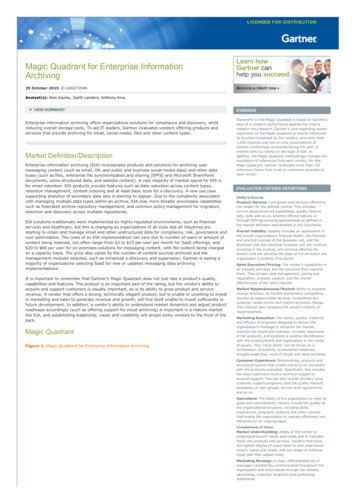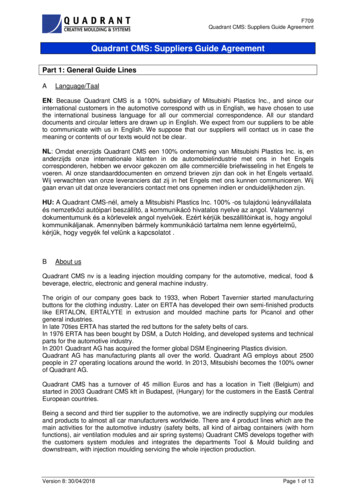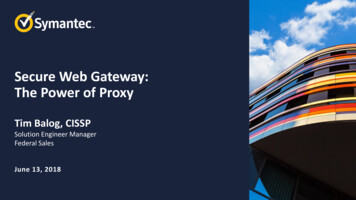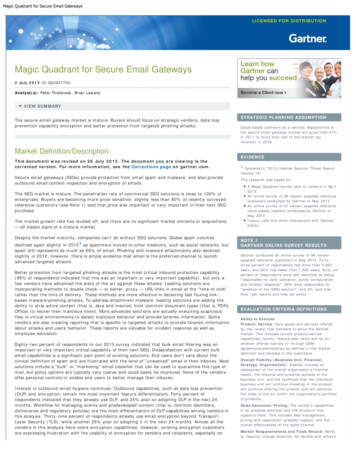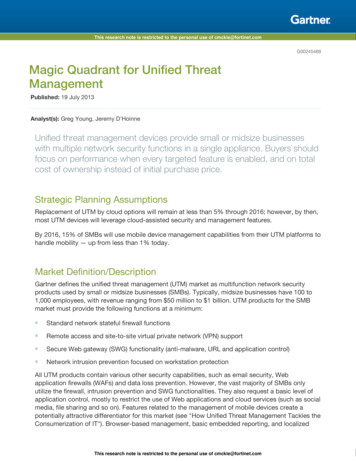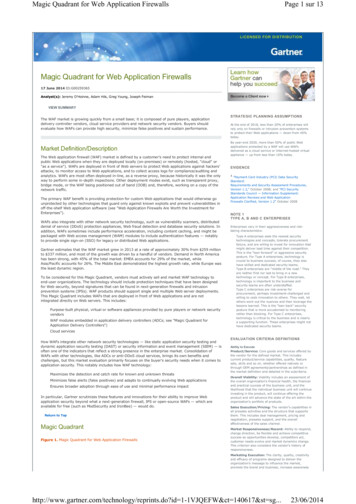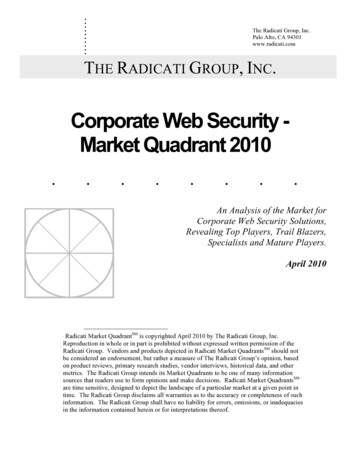
Transcription
.The Radicati Group, Inc.Palo Alto, CA 94301www.radicati.comTHE RADICATI GROUP, INC.Corporate Web Security Market Quadrant 2010 .An Analysis of the Market forCorporate Web Security Solutions,Revealing Top Players, Trail Blazers,Specialists and Mature Players.April 2010Radicati Market QuadrantSM is copyrighted April 2010 by The Radicati Group, Inc.Reproduction in whole or in part is prohibited without expressed written permission of theRadicati Group. Vendors and products depicted in Radicati Market QuadrantsSM should notbe considered an endorsement, but rather a measure of The Radicati Group’s opinion, basedon product reviews, primary research studies, vendor interviews, historical data, and othermetrics. The Radicati Group intends its Market Quadrants to be one of many informationsources that readers use to form opinions and make decisions. Radicati Market QuadrantsSMare time sensitive, designed to depict the landscape of a particular market at a given point intime. The Radicati Group disclaims all warranties as to the accuracy or completeness of suchinformation. The Radicati Group shall have no liability for errors, omissions, or inadequaciesin the information contained herein or for interpretations thereof.
Corporate Web Security - Market Quadrant 2010TABLE OF CONTENTSRADICATI MARKET QUADRANTS EXPLAINED. 3MARKET SEGMENTATION – CORPORATE WEB SECURITY . 5EVALUATION CRITERIA . 6MARKET QUADRANT – CORPORATE WEB SECURITY . 9KEY MARKET QUADRANT HIGHLIGHTS . 10CORPORATE WEB SECURITY - VENDOR ANALYSIS . 11TOP PLAYERS . 11TRAIL BLAZERS . 24SPECIALISTS . 32 Please note that this report comes with a 1-5 user license. If you wish to distribute thereport to more than 5 individuals, you will need to purchase an internal site license for anadditional fee. Please contact us at admin@radicati.com if you wish to purchase a sitelicense.Companies are never permitted to post reports on their external web sites or distribute byother means outside of their organization without explicit written prior consent from TheRadicati Group, Inc. If you post this report on your external website or release it to anyoneoutside of your company without permission, you and your company will be liable fordamages. Please contact us with any questions about our policies. Copyright April 2010 The Radicati Group, Inc. Reproduction Prohibited2
Corporate Web Security - Market Quadrant 2010RADICATI MARKET QUADRANTS EXPLAINEDRadicati Market Quadrants are designed to illustrate how individual vendors fit withinspecific technology markets at any given point in time. All Radicati Market Quadrants arecomposed of four sections, as shown in the example quadrant (Figure 1).1. Top Players – These are the current market leaders with products that offer, bothbreadth and depth of functionality, as well as posses a solid vision for the future.Top Players shape the market with their technology and strategic vision. Vendorsdon’t become Top Players overnight. Most of the companies in this quadrant werefirst Specialists or Trail Blazers (some were both). As companies reach this stage,they must fight complacency and continue to innovate.2. Trail Blazers – These vendors offer advanced, best of breed technology, in someareas of their solutions, but don’t necessarily have all the features and functionalitythat would position them as Top Players. Trail Blazers, however, have the potentialfor “disrupting” the market with new technology or new delivery models. In time,these vendors are most likely to grow into Top Players.3. Specialists – This group is made up of two types of companies:a. Emerging players that are new to the industry and still have to develop someaspects of their solutions. These companies are still developing theirstrategy and technology.b. Established vendors that offer a niche product.4. Mature Players – These vendors are large, established vendors that may offerstrong features and functionality, but have slowed down innovation and are nolonger considered “movers and shakers” in this market as they once were.a. In some cases, this is by design. If a vendor has made a strategic decision tomove in a new direction, they may choose to slow development on existingproducts.Copyright April 2010 The Radicati Group, Inc. Reproduction Prohibited3
Corporate Web Security - Market Quadrant 2010b. In other cases, a vendor may simply have become complacent and be outdeveloped by hungrier, more innovative Trail Blazers or Top Players.c. Companies in this stage will either find new life, reviving their R&D effortsand move back into the Top Players segment, or else they slowly fade awayas legacy technology.Figure 1, below, shows a sample Radicati Market Quadrant. As a vendor continues todevelop its product solutions adding features and functionality, it will move verticallyalong the “y” functionality axis.The horizontal “x” strategic vision axis reflects a vendor’s understanding of the market andtheir strategic direction plans. It is common for vendors to move in the quadrant, as theirproducts evolve and market needs change.HighRadicati Market QuadrantSMMature PlayersTop Players Company LFunctionality Company Z Company Y Company J Company HLow Company D Company BCompany CCompany ASpecialistsLow Company FCompany G Company ETrail BlazersStrategic VisionHighFigure 1: Sample Radicati Market QuadrantCopyright April 2010 The Radicati Group, Inc. Reproduction Prohibited4
Corporate Web Security - Market Quadrant 2010MARKET SEGMENTATION – CORPORATE WEB SECURITYThis edition of Radicati Market QuadrantsSM covers the “Corporate Web Security”segment of the Security Market, which is defined as follows:o Corporate Web Security: is defined as any software, appliance, or hosted servicethat protects corporate users and networks from Web-based malware, helps preventdata loss, and enables organizations to control employee behavior on the Internet.Key players in this market include Aladdin, Barracuda Networks, Blue Coat, CiscoIronPort, M86 Security, McAfee, Symantec, Trend Micro, Webroot, Websense, andothers. Solutions in this market can be deployed in multiple form factors, including software,appliances, hosted and hybrid models. While some product solutions included in this market target both, corporate customersand service providers, this report only looks at vendor installed base and revenuemarket share in the context of their corporate business. We do not include as part of this definition security solutions that protect Websiteservers and Web application servers. We also do not include desktop-based securitysolutions. The worldwide revenue for corporate Web security solutions is expected to grow fromover 1.1 billon million in 2010, to over 2.1 billion in 2014.CorporateWebSecurityRevenueForecast,2010- ‐2014 2,500 1,877Million 2,000 1,500 1,372 2,140 1,618 1,143 1,000 500 020102011201220132014Figure 2: Corporate Web Security Market Revenue Forecast, 2010 – 2014Copyright April 2010 The Radicati Group, Inc. Reproduction Prohibited5
Corporate Web Security - Market Quadrant 2010EVALUATION CRITERIAVendors are positioned in the quadrant according to two criteria: Functionality andStrategic Vision.Functionality is assessed based on the breadth and depth of features of each vendor’ssolution. All features and functionality do not necessarily have to be the vendor’s ownoriginal technology, but they should be integrated and available for deployment when thesolution is purchased.Strategic Vision refers to the vendor’s strategic direction, which comprises: a thoroughunderstanding of customer needs, ability to deliver through attractive pricing and channelmodels, solid customer support, and strong on-going innovation.Vendors in the Web Security space are evaluated according to the following key featuresand capabilities: Malware detection is usually based on signature files, reputation filtering (proactiveblocking of malware based on its behavior, and a subsequent assigned reputationscore), and proprietary heuristics. Top players and trails blazers will usually gobeyond the typical set up that usually includes multiple filters, one or more best-ofbreed signature-based engines as well as the vendor’s own proprietary technology.Malware can include spyware, viruses, worms, rootkits, and much more. URL filtering is a very common feature in Web security solutions. It helps promoteproductivity and a malware-free environment by filtering out unwanted websitesbased on URL. Vendors usually offer a number of different categories thatadministrators can choose to filter, which can range from around 10 to 100.Categories often include millions of pre-screened sites, which are updated daily.The number of categories that can be screened is irrelevant. The differentiationfactors lie in how often they are updated (e.g. hourly vs. daily), what scanningtechniques are used (e.g. scanning content on a website vs.URL name), the amountof latency introduced, and other factors.Copyright April 2010 The Radicati Group, Inc. Reproduction Prohibited6
Corporate Web Security - Market Quadrant 2010 Reporting lets administrators view activity that happens on the network. Most Websecurity solutions offer interactive reports on detailed user activities. Summaryviews are available to give an overall view of the state of the network, such as howmany threats were blocked. Most solutions offer similar levels of network-leveldetail. Differences, however, are mostly found in how long the activity becomesavailable for reporting after the activity takes place. Most solutions offer real-timeor near real-time reporting. Reporting is traditionally included in a solution, butsome vendors require it as an add-on to the base Web security offering. SSL scanning was not usually offered as a feature in the past since websites withSSL security were viewed as safe and trust-worthy. Now that malware frequentlyappears on legitimate websites, Web traffic over an SSL connection is alsocommonly monitored to enforce Web policies. SSL scanning has become a muchmore common feature in Web security solutions. Directory integration can be obtained via Active Directory or the LDAP protocol.By integrating Web security tools with a corporate directory, organizations can useemployees’ directory roles to assign and manage Web policies based on a user’sfunction and role in the organization. Nearly all Web security vendors offer someform of directory integration.The following capabilities are viewed as more advanced in the Web Security market,and further add to a vendor’s placement in the right side of the quadrant: Social networking controls are becoming increasingly granular as organizationsseek to control the features available on social networking sites, such as blockingaccess to applications. These types of controls have been some of the mostfrequently requested new features for Web security solutions. Data Loss Prevention (DLP) allows organizations to define policies to prevent lossof sensitive electronic information. Vendors can claim they offer DLP functionalitybased on the fact that some of the features that are standard in Web securitysolutions stop data from leaving the network, such as application blocking. Othervendors take a more vigorous approach and offer keyword blocking and deeperDLP functionality.Copyright April 2010 The Radicati Group, Inc. Reproduction Prohibited7
Corporate Web Security - Market Quadrant 2010 Web 2.0 controls enable organizations to automatically block potentially maliciousapplications, and/or limit the use of non-work related applications. Web securityvendors can vary greatly with regards to the number of protocols and Web 2.0applications on which they can enforce policies. Bandwidth controls allow administrators to completely block bandwidth-hungrysites like YouTube, or they can impose quotas that limit time spent or dataconsumed. This preserves bandwidth for legitimate traffic and application use. Websecurity vendors can differ quite a bit in the level of bandwidth controls offered.Some may offer controls just based on amount of data consumed or time spent on asite, while others may offer detailed controls that can enact a broad variety ofbandwidth policies. Blended attack prevention enables blocking of malicious websites that users aredirected to via a link included in an email message. The malicious code is deliveredvia the link, while the email does not contain any malicious attachments.Sophisticated Web security solutions can detect and block this increasinglycommon form of attack.Note: On occasion, we may put a vendor on the right side of the quadrant (Top Player orTrail Blazer) if we feel that some other aspect(s) of their solution which may not be listedabove is particularly unique and innovative.Copyright April 2010 The Radicati Group, Inc. Reproduction Prohibited8
Corporate Web Security - Market Quadrant 2010MARKET QUADRANT – CORPORATE WEB SECURITYHighRadicati Market QuadrantSMMature PlayersTop PlayersLowFunctionality McAfee Trend Micro WebrootSpecialistsLow Clearswift Aladdin Websens eBlue Coat Cisco IronPort Symantec Barracuda M86 SecurityTrail BlazersHighStrategic VisionFigure 3: Corporate Web Security Market Quadrant, 2010 Radicati Market QuadrantSM is copyrighted April 2010 by The Radicati Group, Inc.Reproduction in whole or in part is prohibited without expressed written permission of theRadicati Group. Vendors and products depicted in Radicati Market QuadrantsSM should not beconsidered an endorsement, but rather a measure of The Radicati Group’s opinion, based onproduct reviews, primary research studies, vendor interviews, historical data, and other metrics.The Radicati Group intends its Market Quadrants to be one of many information sources thatreaders use to form opinions and make decisions. Radicati Market QuadrantsSM are timesensitive, designed to depict the landscape of a particular market at a given point in time. TheRadicati Group disclaims all warranties as to the accuracy or completeness of such information.The Radicati Group shall have no liability for errors, omissions, or inadequacies in theinformation contained herein or for interpretations thereof. Copyright April 2010 The Radicati Group, Inc. Reproduction Prohibited9
Corporate Web Security - Market Quadrant 2010KEY MARKET QUADRANT HIGHLIGHTS The Top Players in the market are Websense, Blue Coat, McAfee, and Cisco IronPort. The Trail Blazers quadrant includes Symantec, Barracuda and M86 Security. The Specialists quadrant includes Trend Micro, Webroot, Clearswift, and Aladdin. Allof these players offer interesting features at an attractive price point, however, they donot offer sufficiently innovative features to be considered a Trail Blazer and also do notyet have a large enough installed base to place in the Top Player quadrant. There are currently no Mature Players in this market.Copyright April 2010 The Radicati Group, Inc. Reproduction Prohibited10
Corporate Web Security - Market Quadrant 2010CORPORATE WEB SECURITY - VENDOR ANALYSISTOP PLAYERSWEBSENSE, INC.10240 Sorrento Valley RoadSan Diego, CA 92121www.websense.comFounded in 1994, Websense provides security solutions to protect corporate Web and email channels, as well as specialized offerings for data security. In 2007 Websenseacquired SurfControl and PortAuthority to enhance its suites with advanced e-mail, Web,and Data Loss Prevention technology.Websense Web security solutions are designed to protect corporate networks frommalicious traffic, prevent loss of sensitive data, and monitor user productivity. In addition,they also enable management of popular Web-based social networks and applications,allowing users to effectively do their job, without compromising corporate security.Websense offers one of the most comprehensive Web security suites available today. Thecompany dominates the higher end of the market, constantly introducing new concepts andsolutions. One of its latest offerings, Websense TRITON (introduced in February 2010),combines all the top features needed for both e-mail and Web protection in a hybridarchitecture.Websense Web Security Gateway (WSG) enables businesses to securely adopt Web 2.0tools. It uses dynamic categorization capabilities to effectively protect users from potentialthreats without the need of reputation technology. Rather than blocking the whole website,it can just block the undesirable content within a website. The Web Security Gateway alsooffers outbound data loss prevention (both native and integrated options with its enterprisedata loss prevention solution, the Data Security Suite) and hybrid deployment, combiningon-premise and SaaS deployment. The Websense Web Security Gateway is available assoftware, on the Websense V10000 appliance, and as a service (SaaS).Copyright April 2010 The Radicati Group, Inc. Reproduction Prohibited11
Corporate Web Security - Market Quadrant 2010Websense Web Security protects organizations from Web-based threats, such as spyware,phishing, and more, combined with the Websense Web Filter. The Websense ThreatSeekerNetwork offers real time analysis to recognize and stop known and unknown threats.Websense Web Filter is a robust Web filtering tool that allows administrators to setacceptable use policies for the Web, providing multiple settings such as Allow, Block,Continue, Quota, Block by Bandwidth, and Block by File Type.Websense Express is targeted towards SMBs with environments under 250 users. Itenables monitoring of user productivity, and helps to eliminate Web threats.Websense also offers Hosted Web Security, delivering web security technology as aservice available integrated with Websense Hosted Email Security.Websense V10000 – available since 2009, it is a virtualized hardware appliance with WebSecurity Gateway features and capabilities. The appliance also integrates seamlessly withWebsense Hosted Web Security for hybrid deployment.Websense TRITON – introduced in February 2010, includes unified policy managementfor on-premise and cloud-based deployments spanning Web, Email, and DLP protection ina unified solution.Websense is also planning to introduce a new hybrid Web Security solution, which willcombine a hosted filter to remove viruses and spam in the cloud, as well as an on-premisessolution for outbound traffic control.STRENGTHS: Websense Web security solutions can be deployed as appliances, services, or hybridsolutions. Websense offers one of the most comprehensive suites of Web security solutions forcompanies of all sizes. It covers all aspects of Web security – from employeeproductivity, to protection from malicious traffic, to data loss prevention.Copyright April 2010 The Radicati Group, Inc. Reproduction Prohibited12
Corporate Web Security - Market Quadrant 2010 Websense is keeping up with emerging Web threats by ensuring that Web 2.0 basedsites and applications are used safely. Instead of blocking complete websites andapplications, Websense enables companies to block just the undesirable content withinthese applications. The latest Websense TRITON is a hybrid offering combining advanced e-mail andWeb protection tools, including DLP features.WEAKNESSES: Large deployments of Websense Web Security Suite can be rather costly. Various capabilities have to be purchased separately, rather than as a single solution. DLP capabilities are very basic. Although this is typical for Web Security vendors,Websense could be more at the forefront of the market, considering how advanced therest of its Web security tools are.Copyright April 2010 The Radicati Group, Inc. Reproduction Prohibited13
Corporate Web Security - Market Quadrant 2010BLUE COAT SYSTEMS420 N. Mary AvenueSunnyvale, CA 94085-4121www.bluecoat.comFounded in 1996, Blue Coat’s original line of solutions included technologies to accelerateInternet browsing. Today, Blue Coat has combined its application acceleration and Websecurity products with its application visibility solutions to offer complete enterprisenetwork control through its Application Delivery Network (ADN) solution set.Blue Coat’s ADN solutions cover three areas: Application Visibility, Classification andPerformance Monitoring (to detect and fix network problems); WAN optimization (to helpaccelerate performance of business applications) through it’s ProxySG appliances andclient software; and Secure Web Gateway technologies (to protect organizations againstmalware, and to help them monitor employees’ productivity) through its ProxyAVappliance and ProxySG appliances and client software.Blue Coat’s solutions are known for their high-performance and, although Blue Coat sellsprimarily into large organizations, it is also currently beginning to target mid-sizeenterprises with its ADN solution set.Blue Coat offers a comprehensive set of Web security solutions. Offered with five layersof defense, these solutions include: the WebPulse cloud service, ProxyAV (anti-malwareprotection) and ProxySG appliances (with DLP technology), and real-time remote userprotection capabilities through ProxyClient.The company’s flagship ProxySG and ProxyAV solutions have the following capabilities:ProxySG is an appliance that ensures that everything from simple browsing to complexWeb applications runs smoothly and efficiently. It gives administrators the ability tomonitor and manage the browsing habits of end users and remove web threats.URL filtering keeps users from visiting inappropriate sites, and application managementcan ensure that bandwidth is not wasted on non-work related activities. The latest versionadds a number of new URL categories, bringing the total number of categories to 80.Copyright April 2010 The Radicati Group, Inc. Reproduction Prohibited14
Corporate Web Security - Market Quadrant 2010ProxySG is continuously updated by the WebPulse community watch cloud service todetect and block malware downloads, phishing attacks, scareware, plus assess reputationsand rate web content.The ProxyAV appliance focuses on stopping malware and web threats from reaching theorganization. The latest version offers better visibility of the inline traffic analysis (such asSSL webmail, etc).Both ProxyAV and ProxySG can work with regular, as well as encrypted traffic. BlueCoat updates its solutions multiple times per day.Over the past 12 months, Blue Coat has also enhanced the available Web reportingcapabilities. The latest version of its Reporter (v9), comes with a new interface,customizable dashboards and reports per category and per user. It offers interactive graphsand charts for easier comprehension, and enables users to view reports online, as well asdownload them to CSV or PDF formats.Blue Coat is starting to see more interest from its customers in its Hybrid Web securitysolutions, which combine appliances and Web security services.STRENGTHS: Blue Coat’s Web security solutions include appliance and services. Blue Coat appliances are high-performance solutions, deployed by very largeorganizations, with some deployments exceeding 100,000 seats. The appliances are known for their high performance, aimed at large enterprises. Both appliances and services offer protection against malware, as well as enablecompanies to monitor users’ browsing habits.Not only HTTP, but also encrypted traffic can be analyzed and managed. Multiple updates are provided throughout the day.Copyright April 2010 The Radicati Group, Inc. Reproduction Prohibited15
Corporate Web Security - Market Quadrant 2010 Hybrid architecture is available on a customized basis.WEAKNESSES: Relatively expensive to deploy and manage. All capabilities are offered separately, so for complete protection organizations willhave to deploy multiple appliances/services. DLP tools are rather basic, contrasting with the more advanced features of the restof the Web security suite. Web Security solutions are not the main focus of Blue Coat. The vendor mostlytargets its own (although quite large) customer base.Copyright April 2010 The Radicati Group, Inc. Reproduction Prohibited16
Corporate Web Security - Market Quadrant 2010MCAFEE, INC.3965 Freedom CircleSanta Clara, CA 95054www.mcafee.comMcAfee is a leader in corporate and consumer security solutions, offering a wide variety ofproducts across many different markets, including e-mail and Web.In November 2008, McAfee acquired Secure Computing, enhancing its line of WebSecurity offerings with technology from one of the top players in the security appliancesmarket.In September 2009, McAfee also completed the acquisition of MX Logic, a provider ofhosted security solutions for e-mail and Web.Appliances: McAfee Email and Web Security Appliance - offers not only anti-virus and antispam protection (with a claimed 98% spam block rate), but also compliance, Webfiltering, anti-spyware, and more for both e-mail and the Internet. McAfee Web Gateway (from Secure Computing’s acquisition) - includesreputation-based web filtering, leveraging Trusted Source (Secure Computing’sglobal reputation service), anti-malware and anti-spyware protection, SSL scanningtechnology, in-depth reporting, and data leak protection. By utilizing proactive,reputation-based filtering, Web Gateway is able to keep up with the latest Webattacks that leverage Web 2.0 technology.McAfee Web Gateway is available on multiple appliance models, a blade serverarchitecture for the largest of enterprises and will soon be available for VMwareenvironments.Copyright April 2010 The Radicati Group, Inc. Reproduction Prohibited17
Corporate Web Security - Market Quadrant 2010SaaS Solutions: McAfee SaaS Web Protection – enables companies to protect all their users,including remote workers, from Web-based threats.To protect against viruses, McAfee SaaS Web Protection utilizes signature-based anti-virustechnology from McAfee and others. The company also incorporates proprietary wormdetection technology to stop new outbreaks that have not been neutralized by a pattern file. Threat Control – offers protection from viruses, fraud, and Web malware. Content Control – enables companies to manage employee Web-related activities.It can block access to potentially dangerous sites, and restrict or limit access toundesirable sites (i.e. networking, entertainment, etc.) Total Control – combines both Threat and Content control at a discounted price.STRENGTHS: McAfee is able to offer Web security appliances and services (through theacquisition of MX Logic). McAfee offers proven anti-virus and anti-malware technology for both e-mail andWeb. Its anti-malware solutions are widely used by many third party providers. The offered solutions enable granular monitoring of user Internet behavior, andprovide basic protection from loss of sensitive information. Secure Web appliances can monitor and manage employee interaction with Web2.0 applications.WEAKNESSES: McAfee is mostly focused on e-mail, rather than Web security, which means that itsWeb security solutions are viewed mostly as an add-on to their e-mail offerings.Copyright April 2010 The Radicati Group, Inc. Reproduction Prohibited18
Corporate Web Security - Market Quadrant 2010 Due to the Secure Computing acquisition, some of the features offered by the twocompanies are still complementary, and may be confusing for customers until amore proper integration takes place. McAfee SaaS Web Protection does not protect against encrypted traffic threats, andoffers no content filtering or DLP capabilities.Copyright April 2010 The Radicati Group, Inc. Reproduction Prohibited19
Corporate Web Security - Market Quadrant 2010CISCO IRONPORT950 Elm Ave.San Bruno, CA 94066www.ironport.comwww.scansafe.comFounded in 2000, IronPort is one of the leading providers of Web security appliances. Thecompany was acquired by Cisco in 2007, but continues to operate as an independentsubsidiary.In December 2009, Cisco acquired ScanSafe, a managed security solutions provider,offering Web security and content management solutions on a hosted basis. With theacquisition of ScanSafe, Cisco IronPort can now also offer Web security solutions asservices. This is especially significant to its larger customers, many of which are nowbecoming interested in deploying a hybrid Web security solution, combining on-premisestools and in the cloud services.Appliances:The Cisco IronPort S-Series is a line of Web security appliances that combinecomprehensive URL, reputation, and malware filtering. The appliances enableorganizations to manage incoming and outgoing Web traffic, including encryptedconnections.Cisco IronPort’s SensorBase reputation network scores the trustworthiness of Web sitesusing over 200 parameters. This score is used by S-Series to block URL requests topossible malicious Web sites or re-direct for further scanning by the AV engines.For malware protection, IronPort uses integrated Webroot and McAfee engines to protectusers from multiple malware attacks. In addition to blocking spyware, the S-Series blocksadware, Trojans, tracking cookies, and other forms of malware.There are three mode
IronPort, M86 Security, McAfee, Symantec, Trend Micro, Webroot, Websense, and others. Solutions in this market can be deployed in multiple form factors, including software, . URL filtering is a very common feature in Web security solutions. It helps promote productivity and a malware-free environment by filtering out unwanted websites

